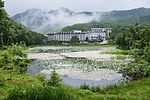The Mihashira or Onbashira (Japanese: 御柱, honorific prefix 御 on-/mi- + 柱 hashira 'pillar') are four wooden posts or pillars that stand on the four corners...
41 KB (4,190 words) - 22:23, 24 November 2023
Gaia-Onbashira is an album by the new age artist Kitarō. It was nominated for the Grammy Award for Best New Age Album in 1998. All tracks are written...
2 KB (73 words) - 07:03, 4 December 2022
studio albums. Among them, the live An Enchanted Evening (1995), Gaia-Onbashira (1998), and Ancient (2001) were all Grammy nominated. In 1999, Thinking...
28 KB (2,778 words) - 22:51, 15 August 2024
shrines, the Tenaga Jinja and the Suwa Jinja. Major festivals include the Onbashira and Setsubun. Hokusai included Lake Suwa in his famous Thirty-six Views...
9 KB (917 words) - 19:04, 23 July 2024
Journey, a 1994 album by the Australian singer Olivia Newton-John Gaia-Onbashira, a 1998 album by the Japanese New Age musician Kitarō GAIA, a 2003 album...
7 KB (902 words) - 00:07, 3 June 2024
symbol of Nagano. It was rung to confer blessing on the opening ceremony. Onbashira — or "sacred pillars" in the Japanese — are large wooden fir posts which...
18 KB (1,885 words) - 17:42, 6 August 2024
Houkisugi at Nakagawa Sugi no Osugi Jōmon Sugi List of superlative trees Onbashira Magewappa a traditional Japanese wood craft using Cryptomeria Thomas,...
19 KB (1,913 words) - 06:08, 25 April 2024
Zenkō-ji temple in Nagano city Five Mountains of Northern Shinshu Zenkō-ji Onbashira, which festival held once in seven years Yashima Wetland in Kirigamine...
20 KB (1,361 words) - 02:48, 23 June 2024
structures with thatched roofs are traditionally rebuilt in turns during the Onbashira Festival, held every six years (in the years of the Monkey and the Tiger...
85 KB (10,068 words) - 03:25, 15 May 2024
celebrated for its Zelkova and momiji. The Honden dates to 1832. The Onbashira Festival, held in the Year of the Tiger and Year of the Rooster, sees...
2 KB (94 words) - 04:18, 4 October 2023







